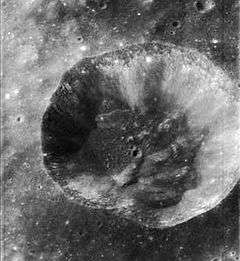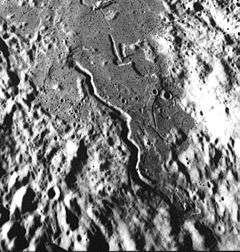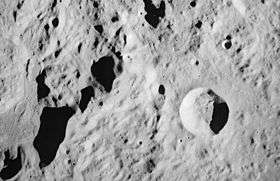Conon (crater)
|
| |
| Coordinates | 21°36′N 2°00′W / 21.6°N 2.0°WCoordinates: 21°36′N 2°00′W / 21.6°N 2.0°W |
|---|---|
| Diameter | 21 km (13 mi) |
| Depth | 2.3 km (1.4 mi) |
| Colongitude | 358° at sunrise |
| Eponym | Conon of Samos |


Conon is a small but prominent lunar impact crater that lies in the eastern foothills of the Montes Apenninus mountain range. Just to the west of Conon is the long mountainous ridge Mons Bradley. The nearest craters possessing an eponym are Galen, about 70 kilometres (43 mi) to the east, and Aratus, about the same distance to the northeast.
The edge of Conon's rim is sharply defined and has not received significant erosion from later impacts. The inner wall is somewhat variable in width, and the interior floor forms an irregular oval shape. This irregularity may be due to the rough and uneven surface on which the crater was formed. The floor is rough, but lacks a central prominence of note.
To the south, in the Sinus Fidei, is a sinuous rille that follows a course to the south-southeast. This rille is designated Rima Conon, and is named after this crater.
The crater is named for the astronomer Conon of Samos (fl. 250 BCE).
Satellite craters
By convention these features are identified on lunar maps by placing the letter on the side of the crater midpoint that is closest to Conon.
| Conon | Latitude | Longitude | Diameter |
|---|---|---|---|
| A | 19.7° N | 4.5° E | 7 km |
| W | 18.7° N | 3.0° E | 4 km |
| Y | 22.3° N | 1.9° E | 4 km |
References
- Andersson, L. E.; Whitaker, E. A. (1982). NASA Catalogue of Lunar Nomenclature. NASA RP-1097.
- Blue, Jennifer (July 25, 2007). "Gazetteer of Planetary Nomenclature". USGS. Retrieved 2007-08-05.
- Bussey, B.; Spudis, P. (2004). The Clementine Atlas of the Moon. New York: Cambridge University Press. ISBN 978-0-521-81528-4.
- Cocks, Elijah E.; Cocks, Josiah C. (1995). Who's Who on the Moon: A Biographical Dictionary of Lunar Nomenclature. Tudor Publishers. ISBN 978-0-936389-27-1.
- McDowell, Jonathan (July 15, 2007). "Lunar Nomenclature". Jonathan's Space Report. Retrieved 2007-10-24.
- Menzel, D. H.; Minnaert, M.; Levin, B.; Dollfus, A.; Bell, B. (1971). "Report on Lunar Nomenclature by the Working Group of Commission 17 of the IAU". Space Science Reviews. 12 (2): 136–186. Bibcode:1971SSRv...12..136M. doi:10.1007/BF00171763.
- Moore, Patrick (2001). On the Moon. Sterling Publishing Co. ISBN 978-0-304-35469-6.
- Price, Fred W. (1988). The Moon Observer's Handbook. Cambridge University Press. ISBN 978-0-521-33500-3.
- Rükl, Antonín (1990). Atlas of the Moon. Kalmbach Books. ISBN 978-0-913135-17-4.
- Webb, Rev. T. W. (1962). Celestial Objects for Common Telescopes (6th revised ed.). Dover. ISBN 978-0-486-20917-3.
- Whitaker, Ewen A. (1999). Mapping and Naming the Moon. Cambridge University Press. ISBN 978-0-521-62248-6.
- Wlasuk, Peter T. (2000). Observing the Moon. Springer. ISBN 978-1-85233-193-1.
